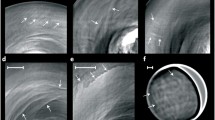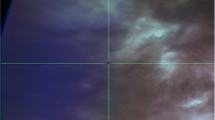Abstract
When seen in ultraviolet light, Venus has contrast features that arise from the non-uniform distribution of unknown absorbers within the sulphuric acid clouds1,2,3 and seem to trace dynamical activity in the middle atmosphere4. It has long been unclear whether the global pattern arises from differences in cloud top altitude (which was earlier3 estimated to be 66–72 km), compositional variations or temperature contrasts. Here we report multi-wavelength imaging that reveals that the dark low latitudes are dominated by convective mixing which brings the ultraviolet absorbers up from depth. The bright and uniform mid-latitude clouds reside in the ‘cold collar’, an annulus of cold air characterized by ∼30 K lower temperatures with a positive lapse rate, which suppresses vertical mixing and cuts off the supply of ultraviolet absorbers from below. In low and middle latitudes, the visible cloud top is located at a remarkably constant altitude of 72 ± 1 km in both the ultraviolet dark and bright regions, indicating that the brightness variations result from compositional differences caused by the colder environment rather than by elevation changes. The cloud top descends to ∼64 km in the eye of the hemispheric vortex, which appears as a depression in the upper cloud deck. The ultraviolet dark circular streaks enclose the vortex eye and are dynamically connected to it.





Similar content being viewed by others
References
Pollack, J. B. et al. Distribution and source of the UV absorption in Venus’ atmosphere. J. Geophys. Res. 85, 8141–8150 (1980)
Esposito, L. W. Ultraviolet contrasts and the absorbers near the Venus cloud tops. J. Geophys. Res. 85, 8151–8157 (1980)
Esposito, L. W. et al. in Venus (eds Hunten, D. M., Colin, L., Donahue,T. M. & Moroz, V. I.) 484–564 (Univ. Arizona Press, 1983)
Rossow, W. B. et al. Cloud morphology and motions from Pioneer Venus images. J. Geophys. Res. 85, 8107–8128 (1980)
Svedhem, H. et al. Venus Express—the first European mission to Venus. Planet. Space Sci. 55, 1636–1652 (2007)
Titov, D. V. et al. Venus Express science planning. Planet. Space Sci. 54, 1279–1297 (2006)
Taylor, F. W., Svedhem, H. & Titov, D. in Exploring Venus as a Terrestrial Planet (eds Esposito, L. W., Stofan, E. R. & Cravens, T. E.) 157–170 (Geophysical Monograph 176, American Geophysical Union, 2007)
Markiewicz, W. J. et al. Venus Monitoring Camera for Venus Express. Planet. Space Sci. 55, 1701–1711 (2007)
Markiewicz, W. J. et al. Morphology and dynamics of the upper cloud layer of Venus. Nature 450, 633–636 (2007)
Esposito, L. W. & Travis, L. D. Polarization studies of the Venus UV contrasts: cloud height and haze variability. Icarus 51, 374–390 (1982)
Drossart, P. et al. Scientific goals for the observations of Venus by VIRTIS on ESA/Venus Express mission. Planet. Space Sci. 55, 1653–1672 (2007)
Taylor, F. W. et al. Structure and meteorology of the middle atmosphere of Venus: infrared remote sensing from the Pioneer orbiter. J. Geophys. Res. 85, 7963–8006 (1980)
Zasova, L. V., Ignatiev, N., Khatuntsev, I. & Linkin, V. Structure of the Venus atmosphere. Planet. Space Sci. 55, 1712–1728 (2007)
Zasova, L. V., Moroz, V. I., Esposito, L. W. & Na, C. Y. SO2 in the middle atmosphere of Venus: IR measurements from Venera-15 and comparison to UV data. Icarus 105, 92–109 (1993)
Sánchez-Lavega, A. et al. Variable winds on Venus mapped in three dimensions. Geophys. Res. Lett. 35 L13204 10.1029/2008GL033817 (2008)
Limaye, S. S. Venus atmospheric circulation: Known and unknown. J. Geophys. Res. 112 E04S09 10.1029/2006JE002814 (2007)
Tsang, C. C. C. et al. Tropospheric carbon monoxide concentrations and variability on Venus from Venus Express/VIRTIS-M observations. J. Geophys. Res. 10.1029/2008JE003089 (2008)
Lellouch, E. et al. in Venus II (eds Bougher, S. W., Hunten, D. M. & Phillips, R. J.) 295–324 (Univ. Arizona Press, 1997)
Piccioni, G. et al. South-polar features on Venus similar to those near the north pole. Nature 450, 637–640 (2007)
Crisp, D. & Titov, D. V. in Venus II (eds Bougher, S. W., Hunten, D. M. & Phillips, R. J.) 353–384 (Univ. Arizona Press, 1997)
Titov, D. V. et al. in Exploring Venus as a Terrestrial Planet (eds Esposito, L. W., Stofan, E. R. & Cravens, T. E.) 121–138 (Geophysical Monograph 176, American Geophysical Union, 2007)
Pätzold, M. et al. The structure of Venus’ middle atmosphere and ionosphere. Nature 450, 657–660 (2007)
Acknowledgements
We thank the European Space Agency (ESA) for its efforts and dedication in implementation of the Venus Express mission and the teams at ESOC and ESAC for operational support. We thank the UK Science and Technology Facilities Council, Italian (ASI) and French (CNES) space agencies for support. N.I.I. acknowledges support from the Russian Foundation for Basic Research.
Author Contributions D.V.T. led the work and studied correlations of the ultraviolet and thermal infrared features in VMC and VIRTIS images; F.W.T. worked on meteorological aspects; H.S. is the Venus Express Project Scientist; N.I.I. derived the maps of cloud top altitude from the VIRTIS spectra; W.J.M., G.P. and P.D. are the Principal Investigators of VMC and VIRTIS experiments and led the observations. All authors discussed the results and commented on the manuscript.
Author information
Authors and Affiliations
Corresponding author
Rights and permissions
About this article
Cite this article
Titov, D., Taylor, F., Svedhem, H. et al. Atmospheric structure and dynamics as the cause of ultraviolet markings in the clouds of Venus. Nature 456, 620–623 (2008). https://doi.org/10.1038/nature07466
Received:
Accepted:
Published:
Issue Date:
DOI: https://doi.org/10.1038/nature07466
- Springer Nature Limited
This article is cited by
-
Clouds and Hazes of Venus
Space Science Reviews (2018)
-
Ultraviolet imager on Venus orbiter Akatsuki and its initial results
Earth, Planets and Space (2018)
-
Venus looks different from day to night across wavelengths: morphology from Akatsuki multispectral images
Earth, Planets and Space (2018)
-
Hinode SOT Plate Scale Reinvestigated by G-Band Images on the 2012 Transit of Venus
Solar Physics (2015)





